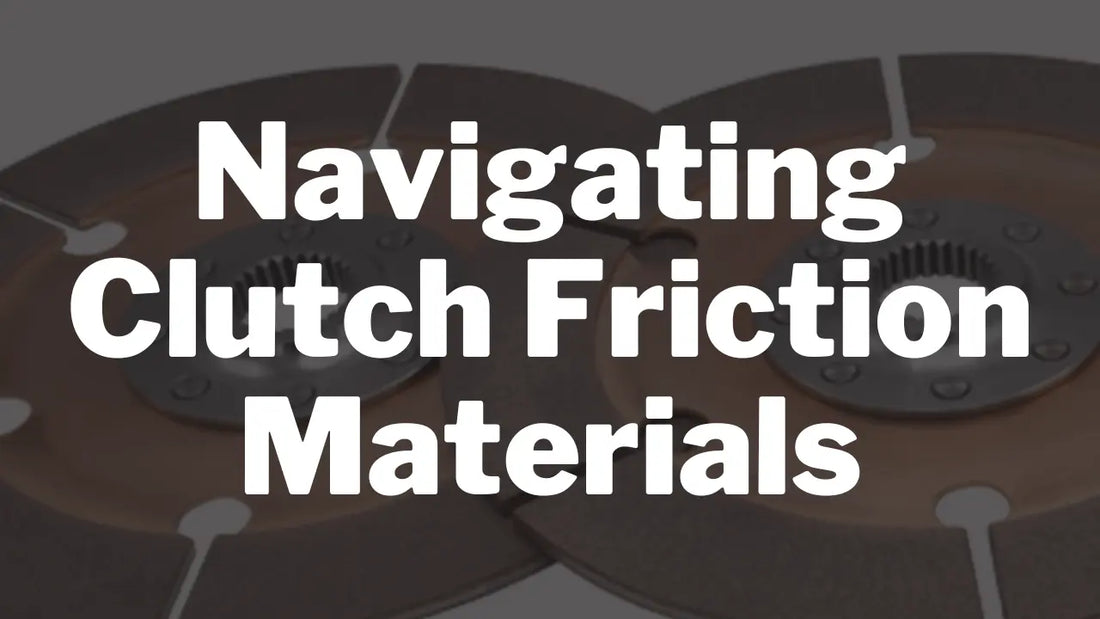
Navigating Clutch Friction Materials: A Guide for Enthusiasts and Builders
When it comes to transferring power through the drivetrain, the clutch plays a critical role—making the choice of friction material especially important. Clutch friction plates must deliver a high coefficient of friction, excellent heat resistance, and durability under pressure. Different materials offer unique benefits depending on the application, whether it’s daily driving, aggressive track use, or all-out racing. Here's a breakdown of the most common clutch friction materials and their key characteristics:
Organic Friction Materials
Overview:
Organic friction materials are the most common choice for OEM applications due to their balance of performance, comfort, and reliability. They offer smooth engagement, solid wear resistance, and minimal break-in requirements—making them ideal for street-driven vehicles.
Composition:
Organic frictions are typically composed of:
- Phenolic resins – a thermosetting polymer formed from phenol and formaldehyde, known for high mechanical strength, thermal stability, and chemical resistance.
- Friction modifiers – such as metallic powders to fine-tune performance.
- Compounded rubber – to increase compliance and reduce harshness during engagement.
Best For:
- Street performance vehicles
- Autocross and track-day builds
- Drivers who want OEM-like engagement feel with added performance
Ceramic Friction Materials
Overview:
Designed for high-performance and racing applications, ceramic friction materials excel under extreme heat and repeated clutch engagement. However, their aggressive nature makes them less suitable for daily driving.
Composition:
Ceramic frictions are typically made from a blend of:
- Copper
- Iron
- Tin bronze
- Silicon dioxide
- Graphite
This compound is sintered or brazed onto a backing plate, which is then riveted to the clutch disc.
Performance Characteristics:
- Very high heat resistance (up to 1000°F without fade)
- Abrupt engagement due to high static-to-dynamic friction ratio
- Ideal for high-RPM shifting and heavy track use
Best For:
- Road racing
- Time attack
- Drag racing
Kevlar Friction Materials
Overview:
Kevlar is a para-aramid synthetic fiber known for its strength, heat resistance, and longevity. Kevlar friction discs offer very smooth engagement and an exceptionally long service life when broken in correctly.
Performance Characteristics:
- Extremely durable under high loads
- Requires a long break-in period (typically 500–1,000 miles)
- Performs well in sustained track conditions
- Not ideal for daily driving in stop-and-go traffic, as overheating can degrade the material
Best For:
- Dedicated track cars
- High-performance street cars driven in spirited conditions
- Applications where long clutch life and smooth engagement are priorities
Cerametallic Friction Materials
Overview:
Cerametallic friction materials blend the benefits of ceramic and metallic components to deliver high torque capacity and long-lasting durability. They’re a go-to choice for serious builds approaching race-level performance without compromising too much drivability.
Composition:
Made from copper-based powder metals, cerametallic discs are engineered to handle extreme power loads and maintain performance even when hot.
Performance Characteristics:
- Aggressive engagement, but more controlled than full ceramic
- Excellent heat tolerance and wear resistance
- Quick engagement ("bite") helps maintain RPMs during shifts
- Break-in period is typically around 500 miles
- Tends to get “grabbier” as temperatures rise
Best For:
- High-horsepower street/track builds
- Drifting, road racing, or heavy forced-induction setups
- Drivers seeking performance just below full-race clutch systems
